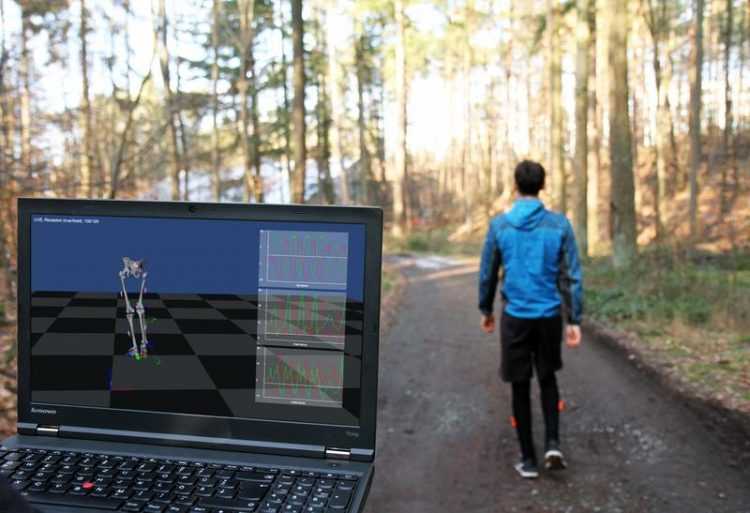Medica 2018: Mobile motion feedback to help patients reduce relieving postures when walking

The movement sequences are measured via small sensors on the feet, legs, and pelvis. Credits: AG wearHEALTH
Dr Gabriele Bleser and her team from the junior research group wearHEALTH at the Technische Universität Kaiserslautern (TUK) are working on a mobile gait analysis system that provides direct feedback to the user. It targets people who suffer from arthrosis, for example, and who receive a new hip joint as a result.
These have usually developed and internalized a relieving posture over many years. “After the operation, the pain is gone, but the posture remains. The 'normal' way of walking has to be learned in rehabilitation and beyond,” says Professor Dr Thomas Jöllenbeck, who heads the Institute of Biomechanics at the Lindenplatz Rehabilitation Clinic in Bad Sassendorf, North Rhine-Westphalia. He and his colleague Juliane Pietschmann work together with the Kaiserslautern researchers.
The technology is intended to support the rehabilitation process. Therefore, seven sensors are used. They are simply attached to the feet, lower legs, thighs, and pelvis. “Accelerations and angular velocities measured by the sensors directly at the body are processed by our software. This software calculates motion parameters such as hip, knee and ankle joint angles as well as step lengths,” explains Dr Bertram Taetz, who, like Markus Miezal, is also involved in the project.
The computer programme thus determines an individual movement pattern that shows whether there are deviations or individual peculiarities in the gait. “The user receives immediate feedback and information via sound and vibrations, with which he can become aware of his gait pattern,” says Bleser.
“Our long-term goal is to develop a mobile system that allows patients to continue training at home even after rehab.” But it's not just the patient who receives feedback; physiotherapists and physicians can also see the data directly on a screen in the form of an animated 3D bone model and diagrams that make special features in the gait easily visible.
This technology is not only interesting for orthopaedic rehabilitation but also patients after a stroke could practice with it. In addition, the application is interesting for various types of sports, for example to study or optimize movement sequences.
“Our system is currently still in the development phase. Studies on patients are still pending. It will be some time before it can reach the market,” Taetz continues. “We also have to significantly increase wearing comfort,” says Bleser. The team is working with computer scientist Professor Dr Didier Stricker from the German Research Centre for Artificial Intelligence in Kaiserslautern to connect a lightweight sensor network to the system.
Also involved in the gait analysis technology at the TUK are sports scientists led by Professor Dr Michael Fröhlich, who are investigating whether the system meets practical requirements, and engineers led by Professor Dr Norbert Wehn, who are working on improving the transmission technology. The work is funded as part of the “Innovative Universities” federal-state initiative, in which the TUK and Kaiserslautern University of Applied Sciences are involved in the “Open Digitisation Alliance Palatinate” project.
The Kaiserslautern junior research group wearHEALTH is an interdisciplinary team from the fields of computer science, mathematics, psychology, cognitive science, motion science and control engineering. They develop digital techniques that are intended to improve health preventively or, for example, in the form of rehabilitation measures.
The team is funded by the Federal Ministry of Education and Research as part of the “Interdisciplinary Competence Building in the Research Focus Human-Technology Interaction for Demographic Change” measure.
Dr Gabriele Bleser
AG [working group] wearHEALTH
Phone: +49(0)631 205-3327
E-mail: bleser[at]cs.uni-kl.de
Dr Bertram Taetz
AG [working group] wearHEALTH
Phone: +49(0)631 205-2644
E-mail: taetz[at]cs.uni-kl.de
Media Contact
More Information:
http://www.uni-kl.deAll latest news from the category: Trade Fair News
Newest articles

Innovative 3D printed scaffolds offer new hope for bone healing
Researchers at the Institute for Bioengineering of Catalonia have developed novel 3D printed PLA-CaP scaffolds that promote blood vessel formation, ensuring better healing and regeneration of bone tissue. Bone is…

The surprising role of gut infection in Alzheimer’s disease
ASU- and Banner Alzheimer’s Institute-led study implicates link between a common virus and the disease, which travels from the gut to the brain and may be a target for antiviral…

Molecular gardening: New enzymes discovered for protein modification pruning
How deubiquitinases USP53 and USP54 cleave long polyubiquitin chains and how the former is linked to liver disease in children. Deubiquitinases (DUBs) are enzymes used by cells to trim protein…



